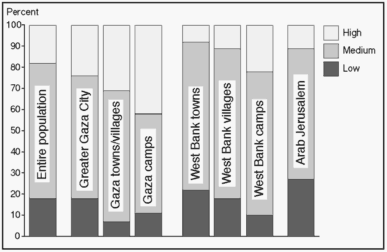
|
|||||||||||||||||||||||||||||||||||||||||||||||||||||||||||||||||||||
Privacy and housing densityThe usual international measurement of housing density is the number of persons per habitable room within a housing unit. For a discussion of the mean household size by type of locality in the occupied territories, see chapter 2 of this report.Survey figures for the mean number of rooms per housing unit, excluding kitchens, bathrooms and hallways, but including glassed-in verandas, are shown in table 3.3.
Table 3.3 Number of rooms/housing unit by locality
On the basis of these figures and average household size, the average number of persons per room in the various types of localities covered by the survey is shown in figure 3.1.
Figure 3.1 Persons per room by locality and in neighbouring countries5 Three or more persons per inhabitable room is a fairly common international criterion for over-crowdedness. Comparable figures for neighbouring countries are scarce. Nonetheless, figure 3.2 can provide one basis for comparison.
Figure 3.2 Percent with three persons or more per room As mentioned, however, persons per habitable room can be a misleading indicator because allocation of space within a house is culturally variable. In the occupied territories a disproportionate amount of space is often occupied by one room only, the living room or salon. Another measurement of density involves the mean square meters of total living space, including kitchens and bathrooms, available to each person. The survey estimates for this measurement are shown in table 3.4.
Table 3.4 Mean square meters per housing unit
Density is also modified by other types of private space which provide household members with closed-off room for socializing and conduct of daily activities. The most important of these are useable roof areas and courtyards, a common architectural feature in Palestinian house construction.
Table 3.5 Percentage of palestinian households with gardens, courtyards or roof areas by type of locality
Table 3.5 indeed underlines the special difficulties Gaza camps. In order to make some general comparison of human density between the different localities in the occupied territories, the various elements that affect living density were assembled into one index.6 The main weighing is on the number of persons per room. One person or less is considered low density, three or more high density. However, taking into consideration the manner in which Palestinian homes are actually constructed and utilized, the presence of a courtyard and a roof terrace used for domestic activities and frequently, also, for sleeping in the warmer months, is also included in the index. Thus, if house density is three or more persons per room, but the house contains both a courtyard and a roof area, the household will be classified as having medium density rather than high density occupancy. The resulting density index shows the following distribution for the various Palestinian localities. Figure 3.3 shows the distribution of household density rates within the different types of localities considered and makes comparisons between locality types feasible. Because courtyards and roof areas are included in the index, it can be noticed that West Bank villages, for instance, in which 23% of all households have houses which contain three or more individuals per room, have the same percentage of high density occupancy as Arab Jerusalem where the presence of these private spaces is less prevalent. The figures show that human crowdedness is highest in Gaza and most acute in the Gaza refugee camps.
Figure 3.3 Relative density of palestinian households by type of locality However, human density on private space is also dramatically effected by human density on adjoining space. It makes a great deal of difference to a person's sense of over-crowdedness if an overcrowded household is surrounded by large, tranquil areas of agricultural land or is tightly and noisily entrapped between other overcrowded households. The survey figures for population per square kilometre have been presented previously in this report. Therefore, it should be noted that the human congestion of Gaza households is exacerbated by the high degree of human congestion in Gaza generally.
|
|||||||||||||||||||||||||||||||||||||||||||||||||||||||||||||||||||||
 al@mashriq 960715 |


